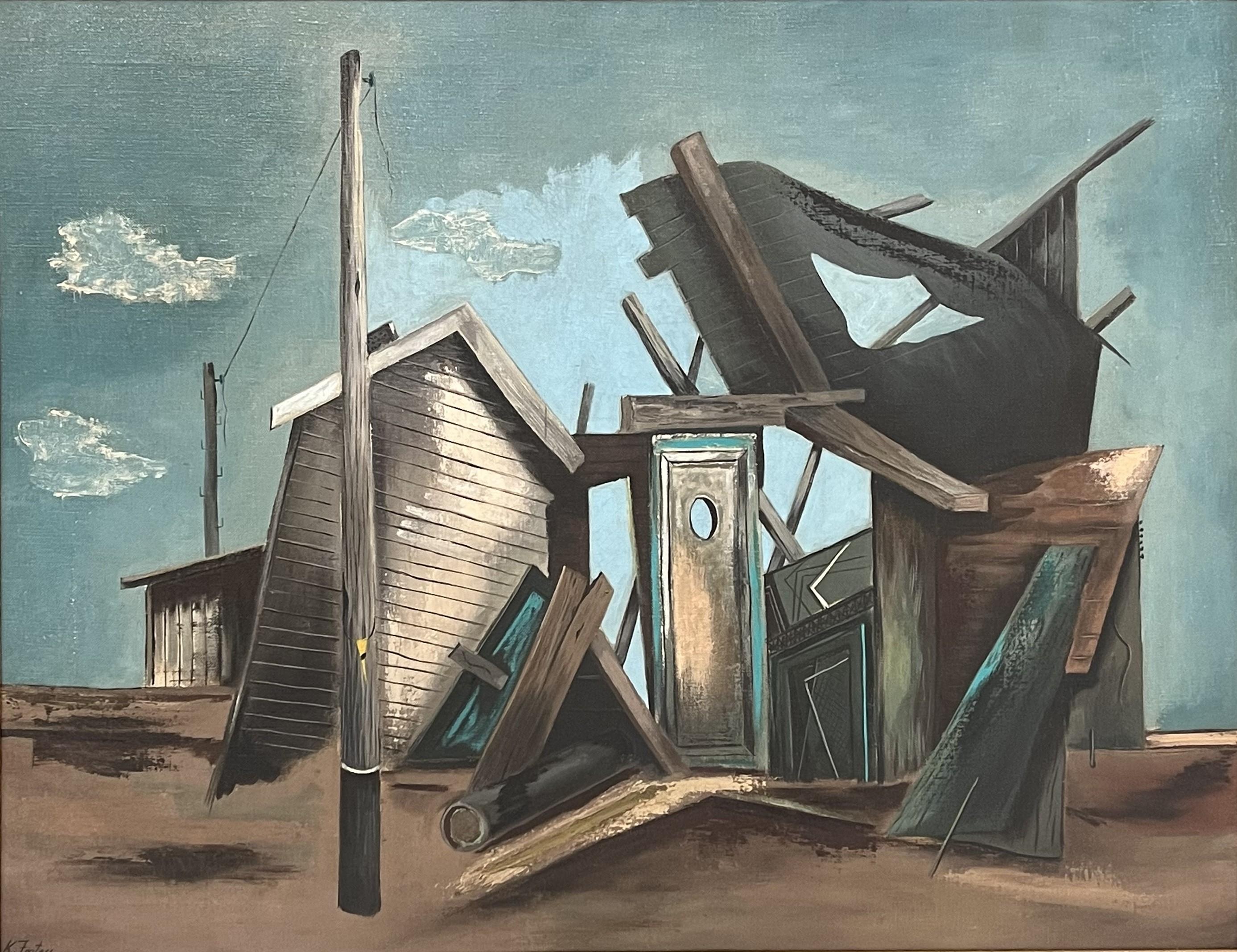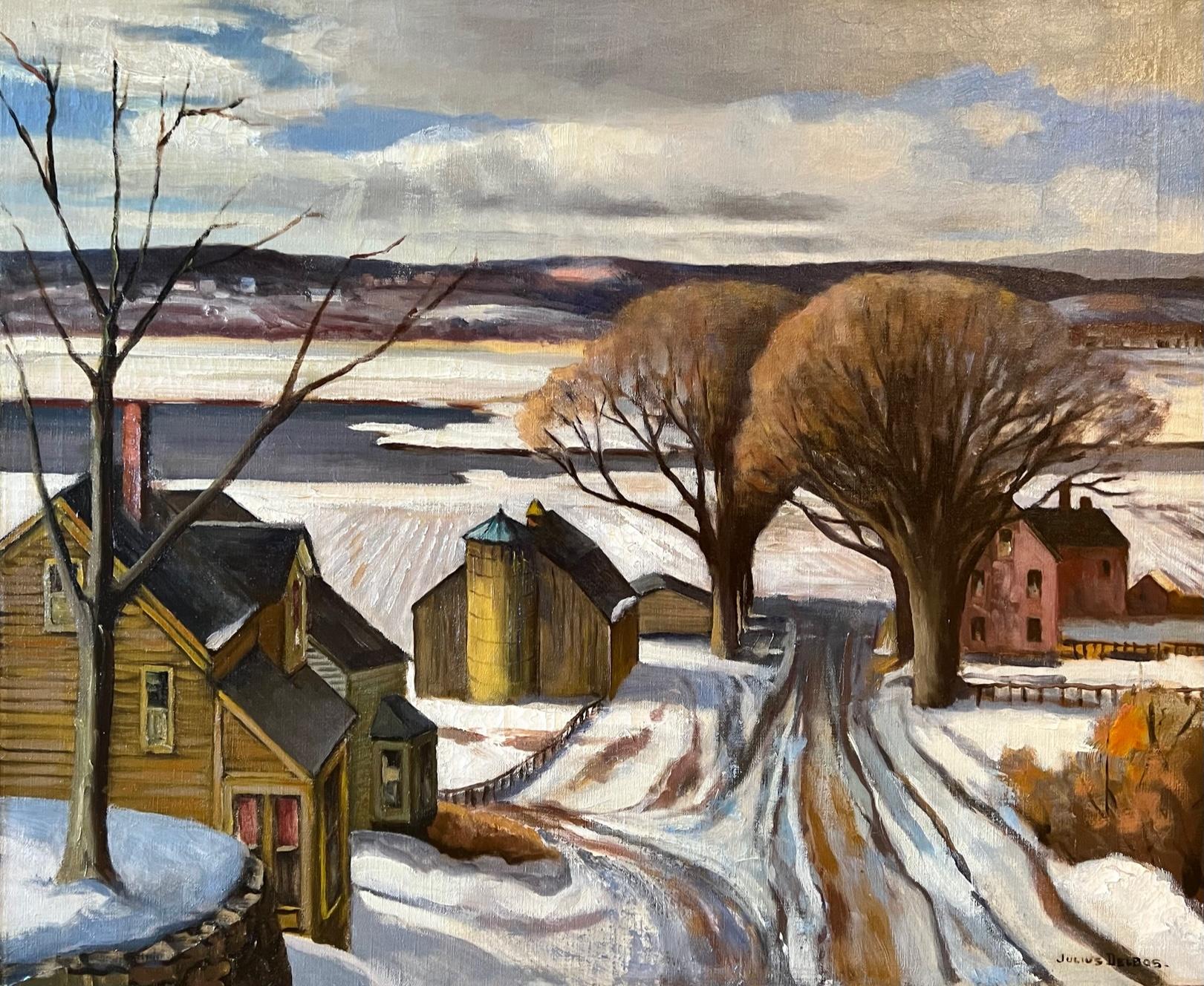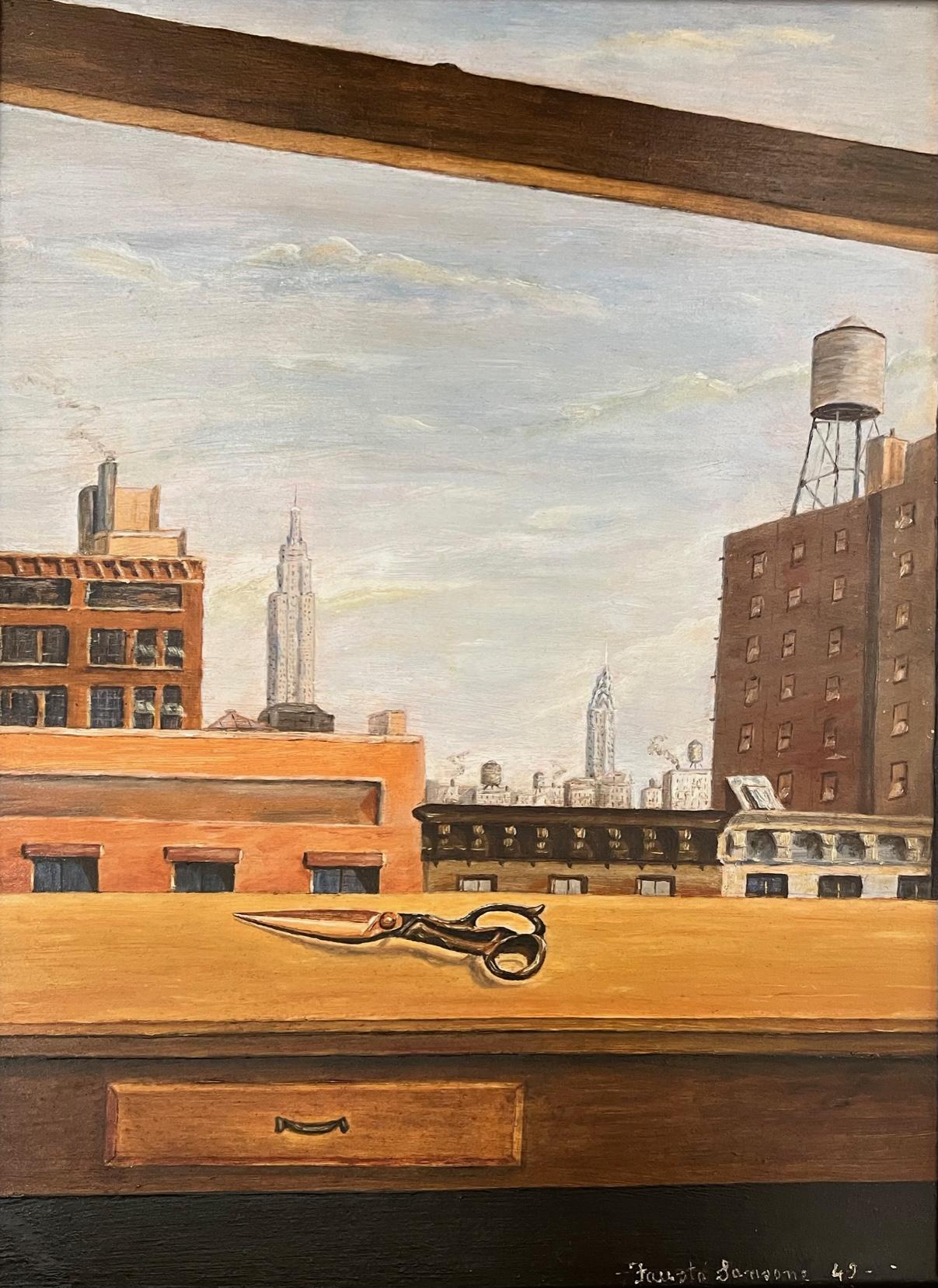Items Similar to Mountain Landscape, Colorado Springs, Colorado, Framed Landscape Oil Painting
Video Loading
Want more images or videos?
Request additional images or videos from the seller
1 of 18
Mary Cane RobinsonMountain Landscape, Colorado Springs, Colorado, Framed Landscape Oil Painting
About the Item
Mountain Landscape, Near Colorado Springs, Colorado is a vertical oil on board painting by Mary Cane Robinson. Presented in a custom frame, outer dimensions measure 28 ⅞ x 18 ⅝ x 1 ½ inches. Image size is 23 ½ x 13 ¼ inches.
Painting is clean and in very good vintage condition - please contact us for a complete condition report.
Expedited and international shipping is available - please contact us for a quote.
About the Artist:
Mary Cane Robinson was born in 1910 in New York City, the daughter of one of the foremost art educators of her day, Florence Cane of the Florence Cane School, and of Melville Cane, a copyright lawyer and poet. Mary was an identical twin. She attended a school founded by her aunt, of the first progressive schools in the city, the Walden School, from preschool until graduation in 1928. At the age of eighteen, she traveled to Germany and studied drawing in Munich for one year with the abstract expressionist, Hans Hofmann. This was an important and vital experience for Robinson as she worked daily with life models.
Robinson returned to New York and in the 1930s studied art with Jean Charlot at her mother's school and at the Pratt Institute. She taught art at the Dalton School for three years and at The Hessian Hills School in Croton-On-Hudson.
Robinson states that there was no single influence on her art. Living in New York City, she was exposed to much art, old and new, European and American. Fauvism, cubism, abstraction, abstract expressionism, and minimalism were stimulating and exciting components of the New York art scene. Some of the artists who may have influenced her work are Marin, Hartley, Demuth, Klee, Redon, Matisse, and Miro.
Mary Robinson moved to Denver in 1947. She was active throughout the Denver community teaching and exhibiting art. She studied in Denver with Connie Smith Siegel, Wilbert Verhelst, and her future brother-in-law, Roland Detre. She taught art in the 1950s at the Denver Art Museum and at Graland School. Robinson showed her work at the Denver Art Museum, the Jewish Community Center, the Gilpin County Arts Association, the Boulder Center for Visual Arts, in the cities of San Antonio and Los Angeles, at the several private shows.
Her work evokes the work of the great American modernist, Arthur Dove, in its nonobjective lyricism in which she expresses her inner self. Mary Robinson had a genuine love for nature, from the mountains to the flowers in the garden. She was one of Colorado's most acclaimed expressionist artists. Mary Cane Robinson writes:
"In the fine arts you are researching yourself, trusting your gesture, your brush and your paint. You allow feeling to enter. You do what gives you the most pleasure, what makes you feel good. You aim to sustain that feeling. Each canvas holds a surprise for me. Each picture is an unfolding, a partnership of trust…trust in the unknown."
Robinson's unique vision is the simplicity of a shy artist combined with the subtlety and distinction of a sophisticate. In her best work, she relates the essence of Colorado's natural beauty to herself in a fantasy of color shapes. Robinson worked in all mediums- prints, drawings, watercolors, pastels, oils, and acrylics. She was successful in all because of her journeyman dedication to expressing her feelings through drawing and color. © Elizabeth Schlosser, Modern Art in Denver (1919-1960)
- Creator:Mary Cane Robinson (1910 - 2003, American)
- Dimensions:Height: 28.75 in (73.03 cm)Width: 18.5 in (46.99 cm)Depth: 1.5 in (3.81 cm)
- Medium:
- Movement & Style:
- Period:
- Condition:very good to excellent condition.
- Gallery Location:Denver, CO
- Reference Number:
About the Seller
5.0
Platinum Seller
These expertly vetted sellers are 1stDibs' most experienced sellers and are rated highest by our customers.
Established in 1979
1stDibs seller since 2013
267 sales on 1stDibs
Typical response time: 1 hour
- ShippingRetrieving quote...Ships From: Denver, CO
- Return PolicyA return for this item may be initiated within 7 days of delivery.
More From This SellerView All
- Native American Figures at Taos Pueblo, New Mexico Southwestern Oil PaintingLocated in Denver, COOriginal 20th century oil painting by Wolfgang Pogzeba (1936-1982) with Native American figures standing in bright blankets with adobe buildings in th...Category
Mid-20th Century American Modern Figurative Paintings
MaterialsOil, Canvas
- Homesteaders, 1960s Framed Colorado Mountain Landscape Oil PaintingBy Harold Vincent SkeneLocated in Denver, CO"Homesteaders" is an original oil on board painting by artist Harold Vincent Skene (1883-1978) painted in 1960. The painting depicts two figures plowing a field with a pair of oxen, ...Category
1960s American Modern Landscape Paintings
MaterialsOil, Board
- Fitzhugh Mine, near Leadville, Colorado, Mountain Mining Landscape Oil PaintingLocated in Denver, COOil on mounted paper, Colorado modern mountain landscape painting by early 20th Century female artist, Eldora Pauline Lorenzini (1910- 1993) from 1937....Category
1930s American Modern Landscape Paintings
MaterialsOil, Archival Paper
- Pueblo Near Santa Fe, New Mexico, 1930s Southwestern Landscape Oil PaintingLocated in Denver, COOil on board landscape painting of a Pueblo near Santa Fe, New Mexico signed by artist Eliot Candee Clark (1883-1980), painted in 1932. Signed by the artist in the lower left corner. Composed of shades of brown, tan, and blue. Presented in a custom frame, outer dimensions measure 23 ½ x 25 x 1 3⁄4 inches. Image size is 17 1⁄4 x 19 1⁄2 inches. About the Artist: Son of landscape painter Walter Clark and Jennifer Woodruff Clark, a student of psychic phenomena, Eliot Clark was a precocious artist who became a landscape painter in the late American Impressionist style. Moving to Albemarle, Virginia in 1932, he was one of the few Impressionist artists of the Southern states. Likely this was a result of his association with James Whistler and his painting in 1900 at Gloucester, Massachusetts with John Twachtman, a family friend. Showing his obvious interest in Impressionism, he wrote a book about its exponents including Twachtman, Theodore Robinson, Childe Hassam, Julian Weir, and Robert Vonnoh. Clark was a teacher including at the National Art Club from 1943, the Art Students League, and New York City College. Early in his youth, Clark traveled with his father and other prominent artists to paint in the summer art colonies at Annisquam, Gloucester, Chadd's Ford and Ogunquit where he met artists of stature such as Edward Potthast and John Henry Twachtman. Clark's only formal instruction was a short two months at the Art Students League in New York. His landscapes evoked a "spiritualized rendition of nature" that was to stay with him for the rest of his life. Clark (perhaps related to his mother's interest in physic phenomena) developed an early interest in oriental philosophy that ended up having a major effect on his artistic development, the sense of spirituality in his landscape paintings slowly grew in importance. Clark was educated in the New York public schools, and at age 13 exhibited with the National Academy and the New York Water Color Club. By 1912, he had won national painting awards, and by 1916 was writing books on American artists as well as the history of the National Academy. In his early years Clark was privately tutored, and then later graduated from Washington Irving High School at the early age of fifteen. Although he later was quoted as saying "he had no formal training from his father", his early work was notable influenced by Walter Clark's tonalist style. Between 1904 and 1906, Clark studied in France in Paris and Giverny, and in London he saw the impressionist work of James Whistler. He wrote to his father about the Whistler Exhibit stating that some of Whistler's work impressed him, "not so much in the handling, but in the use of color, and subtle arrangement of line and balance of masses." He engaged in a "walking tour" of Europe with a fellow artist whom he met in earlier in Paris. They visited many of the major galleries in Holland and then traveled through the Alps, finally reaching Venice on August 10, 1906. I n Venice, he produced some Whistlerian style pastels similar to the ones he had seen in the Whistler Exhibition. He returned to New York in 1906, and a year later took a studio in the Van Dyke Studio Building on Eighth Avenue...Category
1930s American Modern Landscape Paintings
MaterialsOil, Board
- City Park, Denver, Colorado, Large Semi Abstract Colorful Oil LandscapeBy Edward MarecakLocated in Denver, COLarge format oil painting on canvas of City Park in Denver, Colorado by 20th century Denver modernist, Edward Marecak. Semi-abstract park scene with various types of trees, figures, ...Category
20th Century American Modern Landscape Paintings
MaterialsOil, Canvas
- Autumn Harvest, Original Semi-Abstract Landscape and Figurative Oil PaintingBy Edward MarecakLocated in Denver, COOriginal framed oil painting on burlap by Edward Marecak (1919-1993) titled "Autumn Harvest" from 1987. Signed and dated by the artist in the lower right corner. Presented in a custom framed, outer dimensions measure 20 x 29 x 1 ⅜ inches. Image size is 19 x 28 inches. Provenance: Estate of the Artist, Edward Marecak Painting is clean and in good condition - please contact us for a detailed condition report. Expedited and international shipping is available - please contact us for a quote. About the artist: Born to immigrant parents from the Carpathian region in Slovakia, Marecak grew up with his family in the farming community of Bennett’s Corners, now part of the town of Brunswick, near Cleveland, Ohio. When he turned twelve, his family moved to a multi-ethnic neighborhood of Poles, Czechs, Slovaks, and Slovenians in Cleveland. His childhood household cherished the customs and Slavic folk tales from the Old Country that later strongly influenced his work as a professional artist. During junior high he painted scenery for puppet shows of “Peter and the Wolf,” awakening his interest in art. In his senior year in high school he did Cézanne-inspired watercolors of Ohio barns at seventy-five cents apiece for the National Youth Administration. They earned him a full scholarship to the Cleveland Institute of Art (1938-1942) where he studied with Henry George Keller whose work was included in the 1913 New York Armory Show. In 1940 Marecak also taught at the Museum School of the Cleveland Institute. Before being drafted into the military in 1942, he briefly attended the Cranbrook Academy of Art near Detroit, one of the nation’s leading graduate schools of art, architecture, and design. A center of innovative work in architecture, art and design with an educational approach built on a mentorship model, it has been home to some of the world’s most renowned designers and artists, including Eero Saarinen, Charles Eames, Daniel Libeskind and Harry Bertoia. Marecak’s studies at Cranbrook with painter Zoltan Sepeshy and sculptor Carl Milles were interrupted by U.S. army service in the Aleutian Islands during World War II. Following his military discharge, Marecak studied on the G.I. Bill at the Colorado Springs Fine Arts Center from 1946 to 1950, having previously met its director, Boardman Robinson, conducting a seminar in mural painting at the Cleveland Institute of Art. Although he did not work with Robinson at the Fine Arts Center, who had become quite ill - retiring in 1947 - he studied Robinson’s specialty of mural painting before leaving to briefly attend the Cranbrook Academy in 1947. That same year he returned to the Fine Arts Center, studying painting with Jean Charlot and Mary Chenoweth, and lithography with Lawrence Barrett with whom he produced some 132 images during 1948-49. At the Fine Arts Center he met his future wife, Donna Fortin, whom he married in 1947. Also a Midwesterner, she had taken night art courses at Hull House in Chicago, later studying at the Art Institute of Chicago with the encouragement of artist Edgar Britton. After World War II she studied with him from 1946 to 1949 at the Fine Arts Center. (He had moved to Colorado Springs to treat his tuberculosis.) Ed Marecak also became good friends with Britton, later collaborating with him on the design of large stained glass windows for a local church. In 1950-51 Marecak returned to the Cleveland Institute of Art to complete his Bachelor of Fine Arts degree. A year later he was invited to conduct a summer class at the University of Colorado in Boulder, confirming his interest in the teaching profession. In 1955 he received his teaching certificate from the University of Denver. Vance Kirkland, the head of its art department, helped him get a teaching job with the Denver Public Schools so that he and his family could remain in the Mile High City. For the next twenty-five years he taught art at Skinner, Grove, East, George Washington and Morey Junior High Schools. Prior to coming to Colorado, Marecak did watercolors resembling those of Winslow Homer, John Singer Sargent and Charles Burchfield. However, once in Colorado Springs he decided to destroy much of his earlier oeuvre, embarking on a totally new direction unlike anything he had previously done. Initially, in the 1940s, he was influenced by surrealist imagery and Paul Klee and in the West by Indian petroglyphs and Kachinas. His first one-person show at the Garrett Gallery in Colorado Springs in 1949 featured paintings and lithographs rendered in the style of Magic Realism and referential abstraction. The pieces, including an oil Witch with Pink Dish...Category
1980s American Modern Landscape Paintings
MaterialsOil
You May Also Like
- Vintage Modernist Landscape Painting, Monument Valley Arizona, listed artistLocated in Baltimore, MDAlthough born in Ohio at the end of the 19th century, Martin Sabransky studied art at Randolph Macon College in Virginia. He began his career path moving west, by first going to Kans...Category
Mid-20th Century American Modern Landscape Paintings
MaterialsOil
- LandscapeBy Marcel Emile CaillietLocated in Los Angeles, CALandscape, 1940, oil on canvas, 24 x 20 inches, signed, dated and titled verso: “Marcel Cailliet ’40 – S.C.” and “Marcel Cailliet Landscape”; likely exhibited at the annual juried st...Category
1940s American Modern Paintings
MaterialsCanvas, Oil
- Untitled (Collapsed Shacks)By Karl FortressLocated in Los Angeles, CAUntitled (Collapsed Shacks), c. 1940s, oil on canvas, signed lower left, 20 ½ x 26 ½ inches, presented in a period frame This work is part of our exhibition America Coast to Coast: ...Category
1940s American Modern Paintings
MaterialsCanvas, Oil
- Untitled (Farm in Winter)By Julius M. DelbosLocated in Los Angeles, CAThis work is part of our exhibition America Coast to Coast: Artists of the 1940s Untitled (Farm in Winter), 1940s, oil on canvas, signed lower right, 26 x 30 inches, presented in an original frame Julius Delbos...Category
1940s American Modern Paintings
MaterialsCanvas, Oil
- My Only Working ToolLocated in Los Angeles, CAMy Only Working Tool, 1949, oil on panel, signed and dated lower right, 16 x 12 inches, remnant of exhibition label verso, exhibited at the Art News Second Annual National Amateur Co...Category
1940s American Modern Paintings
MaterialsOil, Board
- Bathers at the Quarry 1940s American Modernist Oil Painting WPA eraBy Theresa Berney LoewLocated in Surfside, FLSwimmers and sun tanners at the local watering hole. Her birth name was Theresa Berney. At the time of her passing she was known as Theresa Loew. Birth place: Baltimore artist, blo...Category
1940s American Modern Landscape Paintings
MaterialsOil, Board
Recently Viewed
View AllMore Ways To Browse
Used Canes
Vintage Caning
European City Landscape
Mountain Painting With Frame
Mountain Landscapes In Oil
Mountain Landscape Oil Painting
Framed Landscape Painting Mountains
18x18 Vintage Art Frame
Colorado Painting
Painting Of Colorado
German Landscape Oil Painting
Oils Landscape
American Landscape 20th Century Painting Oil
Garden Landscaping Oil Painting
Spring Landscape Oil
Spring Landscape Oil Painting
Landscape Painting In Oils
American Mountain Landscapes





